Imagine stumbling across a bear and Rottweiler battling in the woods. As they face off, you think the dog is in over its head. But then you look at the fixed gaze of the enormous Rottweiler and reconsider. Maybe this battle won’t be one-sided after all.
In a Rottweiler vs. bear battle, which species walks away the winner? Follow along to find out.
Competitor Number 1: Rottweiler
Our first competitor is the fiercely lovable Rottweiler. This breed of domestic dog has a complex history based on its size and strength. Once referred to as “butcher’s dogs,” these canines are an imposing force.
Owners know that they have nothing to fear when their Rottie is around. Filled with determination, it doesn’t back down when this dog sets its sights on a goal. Their endurance and stamina make Rottweilers great working dogs. They can focus with incredible intensity and remember commands with long delays.
As long as they’re properly trained and socialized, this breed is also the perfect family pet. When facing off against a bear, the Rottweiler will have a bite to back up its bark. With one of the strongest bite forces among breeds, Rottweilers can deliver a lot of damage. And their teeth are designed for clamping down and holding on. So, after grabbing ahold of the bear, this dog won’t let go without a fight!
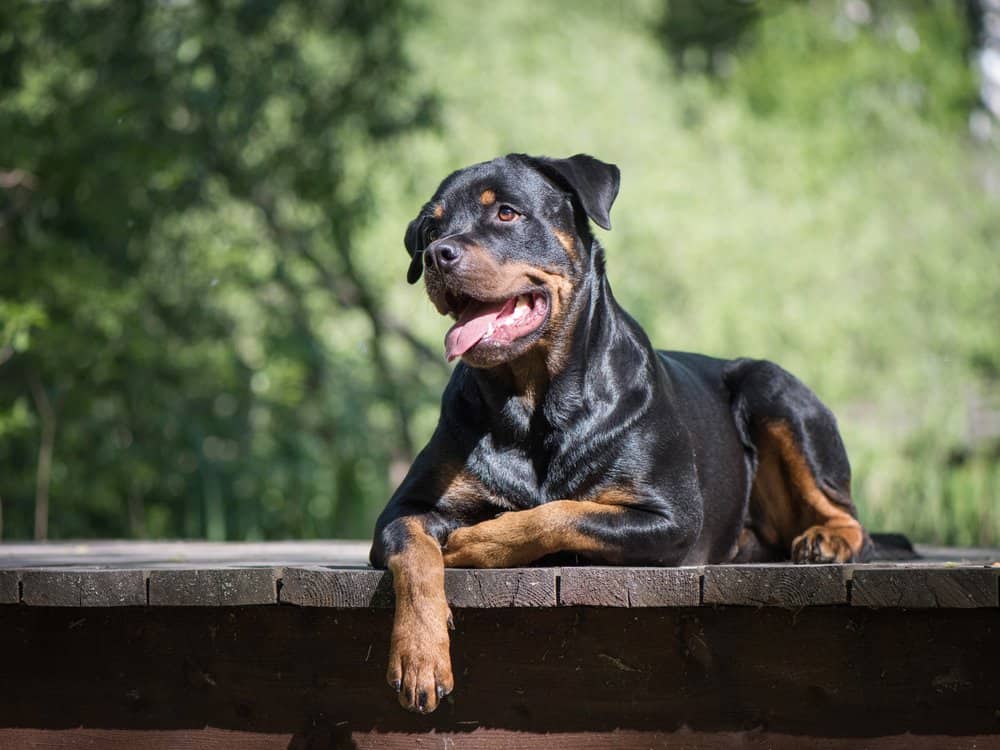
Their endurance and stamina make Rottweilers great working dogs.
©EKATERINA SOLODILOVA/Shutterstock.com
Competitor Number 2: Bear
Our second competitor is a bear. Which bear? We’ll look at a few species to see how they’d stack up against a Rottie. Worldwide, there are eight species of bears.
There are brown bears, polar bears, black bears, sloth bears, sun bears, giant pandas, spectacled bears (sometimes called Andean bears), and Asiatic bears. Certain species live in North America, while others live in South America. You can also find bears in Europe, Asia, and Africa.
The polar bear is the largest bear species, which can weigh up to 1,500 pounds. Their massive size has made them the stars of many folk tales, resulting in tons of polar bear symbolism. Then there’s the smallest bear species, the sun bear. Sun bears can be as small as 60 pounds or as large as 140 pounds. Sometimes sun bears are referred to as honey bears.
Bears have a big appetite. These mammals have a great sense of smell and can detect meals from miles away. As omnivores, they eat a variety of plants and animals. The domestic dog isn’t usually on the menu for a bear, but that doesn’t mean they won’t fight one if they have to! So let’s kick off this Rottweiler vs. bear battle with round one!

Polar bears are the world’s largest bears.
©iStock.com/Alexey_Seafarer
Round 1: History
Our first round for this Rottweiler vs. bear fight is all about history. Where do Rottweilers and bears come from? Historically, Rottweilers have been used for herding, guarding, and police work.
Rottweilers have origins that date back to the Roman Empire. They were used to herd and guard cattle. Sometimes this breed was referred to as butcher’s dogs. This is because of their hard work in the marketplace driving cattle. Their official name comes from the town of Rottweil in southwestern Germany. This area was a major center for cattle trading in the Middle Ages.
Throughout the years, Rottweilers have been known for their loyalty and strength. They never back down from a fight. During the Middle Ages, owners would put their money in the collar of the Rottweiler. They knew that nobody would dare try to steal it.
Since the 1980s, Rottweilers have been a popular breed in the United States. And according to the American Kennel Club, they’re the 8th most popular breed in the entire country. Known for their protective instincts, Rottweilers require proper training and socialization to prevent aggression.
These dogs can be loving, playful, and wonderful in the right environment. And if a rogue bear was to try to attack their family, a Rottweiler would fight to the death.
Bear History
Bears have an intriguing family tree. This family of mammals evolved from a common ancestor around 40 million years. As time passed, different species of bears developed and spread worldwide. Now, you can find bears on every single continent, excluding Antarctica and Australia.
Using their strength, paws, and intelligence, bears are capable of living in a wide range of environments. You can find these fierce mammals in forests, deserts, mountains, and tundras.
Throughout history, bears have had an interest in a relationship with humans. Unfortunately, they’ve been hunted heavily for their meat and for sport. This contributed to the decline of certain species, such as the grizzly bear in North America. But it’s not all bad news. Bears also hold important symbolism and meaning in religious and cultural practices. They play the main characters in a lot of different folk tales and stories that have been told for thousands of years.
Will the bear be strong enough to take down an aggressive Rottweiler? It’ll depend on how these two animals stack up physically. Let’s continue by comparing their anatomy and appearance.
Round 2: Anatomy and Appearance
It’s easy to forget how big Rottweilers are until you see one in person. Then you’re suddenly reminded of how tall and heavy they can be. This breed stands 24 to 27 inches at the shoulder and weighs between 95 to 135 pounds. Females are usually slightly smaller. Of course, there are always exceptions that far outweigh the standards. Take, for instance, this 195-pound Rottweiler named Blondie!
Rottweilers have a famous black coat and distinctive tan markings on their chest, face, and legs. Their musculature is robust and contributes to their strength and endurance. This breed has a high percentage of lean muscle mass compared to other dog breeds.
All it takes is one glance to notice you’re looking at the broad, powerful head of a Rottweiler. Their jaws are strong, and the muzzle is relatively short compared to other breeds. They also have ears that are set high on their head. The ears fold down towards their cheeks.
Rottweilers also have a deep and broad chest contributing to their strong build. Their large feet, with well-arched toes, also guide their movements. And the thick pads on their feet make them well-suited for outdoor activities. These dogs move with confidence and power. They have a strong, balanced stride.
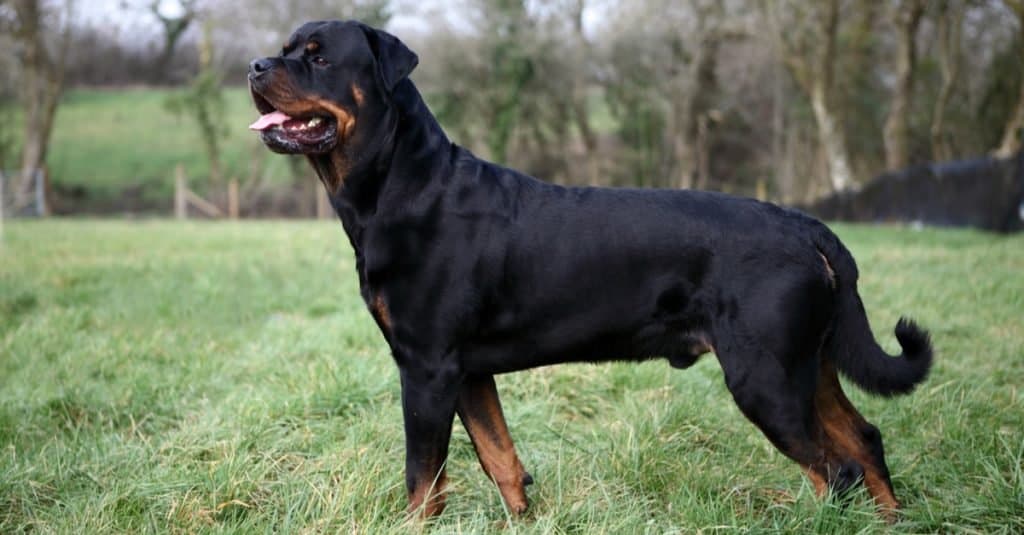
Rottweilers’ musculature is robust and contributes to their strength and endurance.
©Miroslav Cik/Shutterstock.com
Bear Anatomy and Appearance
In a Rottweiler vs. bear battle, looks can be deceiving. Turns out, black bears aren’t always black; sometimes, they’re brown. A bear’s color and size depend on its species and location.
What about the bear’s teeth and claws? A bear’s teeth adapt to its diet. That means their teeth can eat a variety of meat and plants. They also have claws for digging, climbing, and catching prey. The claws are retractable, which helps them stay sharp.
Have you ever noticed that some species of bears, such as the grizzly bear, have a big hump on their back? The distinctive hump is a muscle. This muscle helps give them the power they need to move with speed and dig with force.
As if their teeth and claws weren’t scary enough, bears also have crazy powerful paws. All it would take is one swipe of a bear’s paw to knock the Rottweiler down for good. And each bear specie’s paw is specially designed for where they live. For instance, polar bears have paws that are well suited to walking on ice and snow.

The distinctive hump on a grizzly bear is a muscle, which helps give them the power they need to move with speed and dig with force.
©Perpis/Shutterstock.com
Round 3: Physical Strength
When it comes to a Rottweiler vs. bear battle, how do bite strength, endurance, and muscle mass come into play? Rottweilers have a bite force of 328 PSI. That’s an incredibly high bite compared to other dogs.
Along with being strong and athletic, Rottweilers also have a lot of endurance. After all, they were bred to work long hours. It’s almost as if they have endless energy. This breed can run and play for hours without getting tired. And in this case, they can fight a bear without wearing out.
One of the things that makes them so strong is their musculature. Rottweilers have a lot of muscle mass. And despite their compact bodies. They’re still incredibly agile. These dogs can jump, run, and maneuver quickly and efficiently. They’re well suited for agility training and could easily run circles around a bear.
When you throw the Rottweiler’s determination and dominance into the mix, it’ll have a standing chance of fighting a bear. They’re naturally protective of their owners and their property. They have a strong sense of loyalty and will do whatever it takes to protect their post. This includes using their bite strength, speed, and whatever it takes.
Charging like wild boars or angry rhinos, Rottweilers bring the right type of attitude to a bear fight. They’re comfortable controlling their environment with force when necessary. And in this case, they’ll use everything they have to take the bear down.
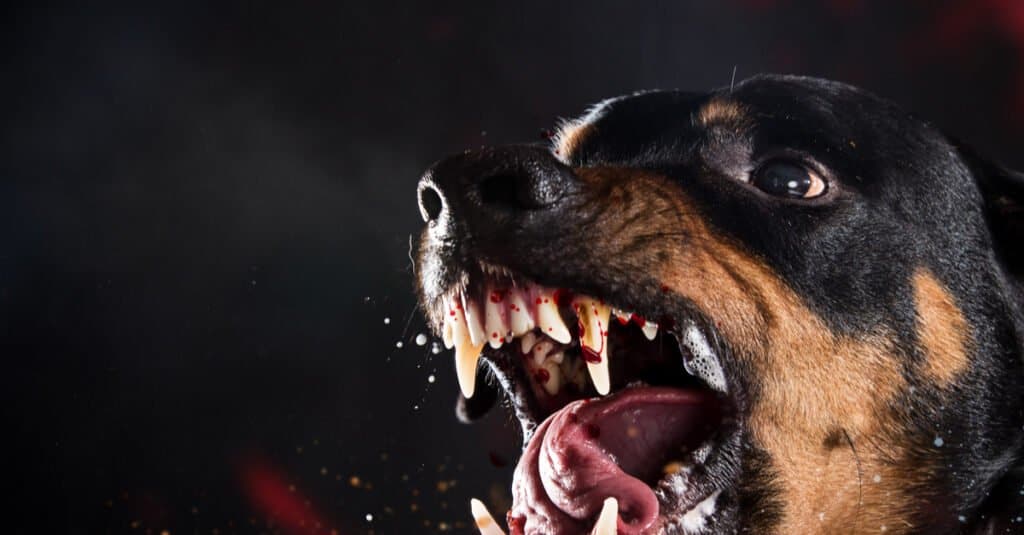
Rottweilers have a bite force of 328 PSI. That’s an incredibly high bite compared to other dogs.
©Lukas Gojda/Shutterstock.com
Bear Physical Strength
How does the bear’s physical strength, bite force, and endurance compare to the Rottweilers? The bear takes the win in every category. They’re stronger, have a deadly bite, and can last long in a fight. And one major thing the bear has over the Rottweiler is their lifting power.
Bears can lift over 1,000 pounds. That means a bear could live with 10 Rottweilers at once! The Rottweiler wouldn’t be able to lift half a bear.
In a Rottweiler vs. bear battle, the bear could pick the dog up and throw it to the ground. Stunned from the fall, the bear would then be able to run over to the Rottweiler and deliver a powerful bite. Certain bear species have a bite force of 1200 PSI.
Bears aren’t only strong, but they also have impressive endurance. They can run and swim for long distances without getting tired. If a Rottweiler and bear were to fight, the battle could last for a long time. And similar to Rottweilers, bears have a ton of muscle mass, which contributes to their strength and speed. These mammals can climb trees, swim and turn on a dime. Even when they’re running at fast speeds of 20 mph, bears can change direction at a moment’s notice.
As for their work ethic, bears are a determined species. They’ll spend hours searching for food. They’re not easily deterred. If a bear decides to pick a fight, it’ll be hard for the dog to escape. And since bears are adaptable animals, they’ll be able to chase their opponent into a variety of environments.
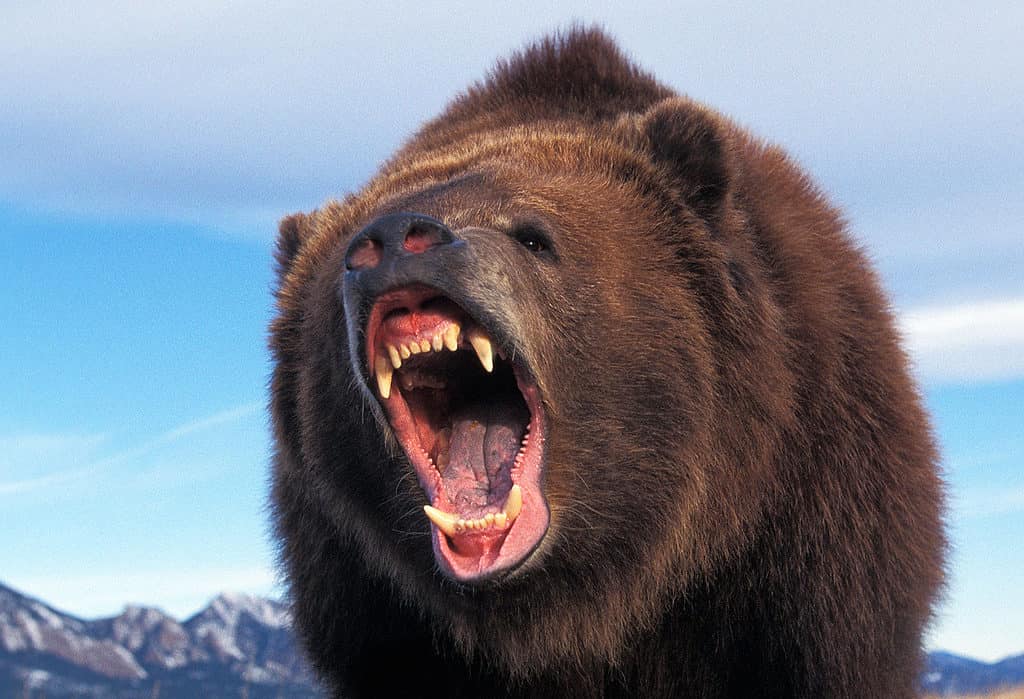
Certain bear species have a bite force of 1200 PSI.
©slowmotiongli/Shutterstock.com
Round 4: Problem-Solving Skills
Who’s the smarter competitor? The bear? Or the Rottweiler? To answer this question, let’s look at each animal’s problem-solving skills.
Rottweilers are highly intelligent canines that are capable of solving a variety of puzzles. This breed can solve certain puzzles within 70 seconds or less. They’re very quick learners and can even learn new commands with an average of five repetitions. And thanks to a strong memory, they can remember commands after a delay of up to ten minutes.
As for decision-making, Rottweilers can make smart decisions based on their experience and training. They can assess the situation and then choose the appropriate course of action.
What about bears? It turns out bears are smarter than we thought. A recent study shows that American black bears have higher cognitive abilities than researchers ever believed possible. After testing the bear’s ability to distinguish between arrays and dots presented on a touchscreen computer, we now know these mammals are smart thinkers. Even when researchers tried to confuse the bears by rearranging the arrays, the mammals could still distinguish the dots.
Another sign of intelligence is their ability to use tools. Sometimes black bears will use a stick to grab food out of hard-to-reach places. They can also apply their knowledge from the past to new situations. This helps them find food and avoid danger. For instance, if a black bear uses a stick to score an insect meal successfully, it’ll be even more skilled at the task the second time. They’ll use their experience, smarts, and motor skills to perfect their bug-catching abilities.
It’s not likely that the bear in this animal in battle has never come across a Rottweiler before. And it’s even more unlikely that they’ve ever had an experience fighting any dog. That means the bear will have to think on their feet to make the right decision. Rottweilers aren’t the ones to wait. It’ll only be a few moments before the large dog launches an attack.
Who Wins?
The bear is the winner. Let’s look at why! In a Rottweiler vs. bear battle, there is much to consider. Physical strength, intelligence, history, and more all come into play. And for this match-up, both species bring a lot to the fighting ring.
Both species have a high amount of muscle endurance and determination. They would go all out and possibly fight to the death. The exact winner would depend on the context of the battle. However, when comparing the species’ physical stats, the bear has the leading advantage in every category. Bears are much larger, stronger, faster, and more capable of defeating their opponent.
That’s not to say this wouldn’t be a close call. The bear isn’t fighting a Chihuahua. It’s fighting a 135-pound Rottweiler. And along with size, this breed has a ton of strength and determination. With a history originating as a guarding dog, Rottweilers are known for their fierce, protective abilities.
Should a bear threaten a Rottweiler’s loved ones, this dog wouldn’t mind going all out to eliminate the threat. But even if they gave it their all, they simply wouldn’t have what it takes to kill a bear. Bears have a bite force that well exceeds the Rottweilers. And when you add their claws and teeth into the mix, the dog, no matter how determined, is outmatched.
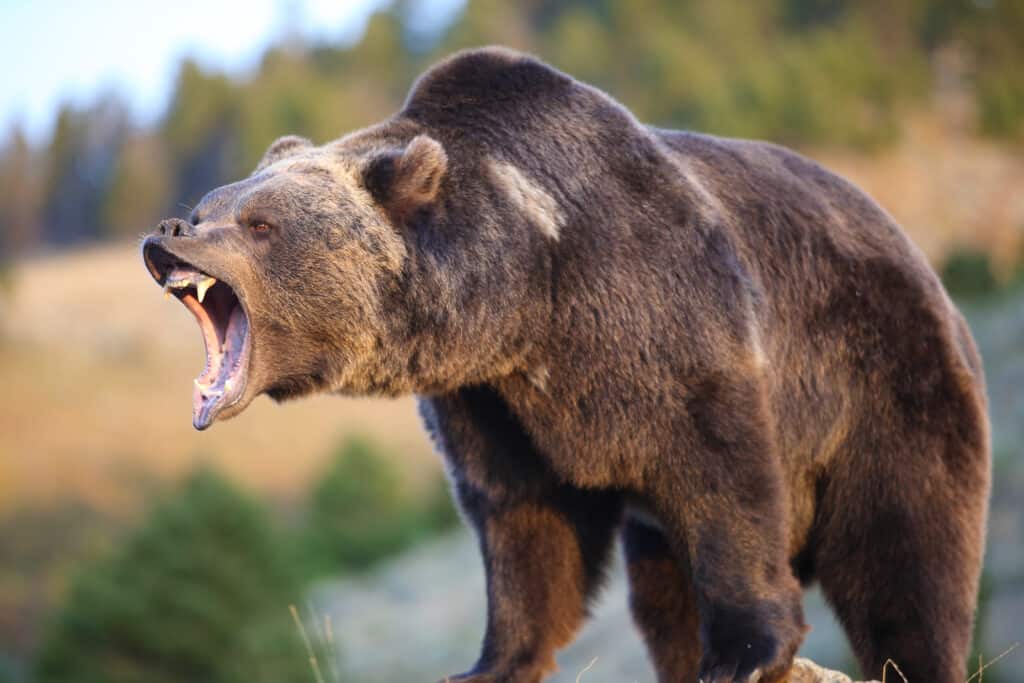
The bear is the winner. Bears are much larger, stronger, faster, and more capable of defeating their opponent.
©Dennis W Donohue/Shutterstock.com
How Could the Rottweiler Win?
When is this animal battle taking place? The bear will have a disadvantage if it’s during the winter season. Black bears lose 23% of their strength during overwintering. This is a small percentage compared to the likely 90% loss of strength humans experience. However, it’s enough of a strength loss to give the Rottweiler a fighting chance. However, if the Rottweiler is facing off against a large 1500-pound polar bear, there’s no hope.
The photo featured at the top of this post is © Scott E Read/Shutterstock.com
Thank you for reading! Have some feedback for us? Contact the AZ Animals editorial team.






